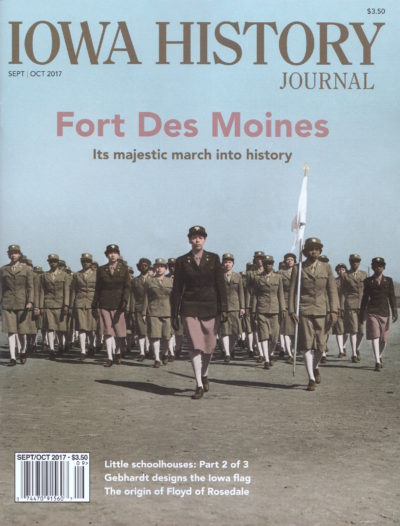
Women’s Army Auxiliary Corps. (WAAC) Capt. Charity Adams of Columbia, N.C., who was commissioned from the first officer candidate class and was the first of her group to receive a commission, leads her company on the drill ground at the first WAAC Training Center at Fort Des Moines in May 1943. Photo courtesy of the U.S. National Archives and Records Administration, 531334. Colorized by Kathy Downing.
By Penelope A. LeFew-Blake, Ph.D.
By the time I was 10 years old, I had heard hundreds of my mother’s stories of her days in the military and seen many pages from her scrapbook of Fort Des Moines. She served there as a captain in the Women’s Army Corps from 1942 to 1946. When I actually saw the fort for the first time on a road trip west with my parents in 1967, I immediately recognized the red brick buildings I had seen so often in her old photographs. My mother had not seen her beloved fort since walking out of its old stone gate more than 20 years earlier.
We passed through that same gate and into a world that existed mostly in her memory. Though some of my mother’s old fort still stood, most of this historic treasure, once bustling with thousands of female soldiers in khaki uniforms, had been destroyed, or allowed to fall to ruin. Incongruous apartment buildings occupied sections of the expansive Parade Ground where vast numbers of women once marched for freedom and into the history books.
Two years after my mother’s death in 1998, I returned to Fort Des Moines. I simply wanted to see what was left of the place my mother loved so dearly.
These days, modern apartments still interrupt the beauty of the east end of the Parade Ground. Across the street stands an impressive building which served as the Bachelors Officers’ Quarters and Officers’ Club during World War II. In recent years, it functioned as the Fort Des Moines Museum & Education Center after it was restored, faithful to its original exterior, but with an updated interior which served its modern role of preserving the legacy of a fort that changed U.S. military history, not once, but over and over again. Unfortunately, the museum is now closed and news broke in July that a developer has begun work on a $40 million renovation of the fort, including the conversion of six buildings into low-income apartments.
Time marches on, but the fort’s history is not forgotten.
TO READ MORE ABOUT THIS STORY AND OTHER FASCINATING STORIES ABOUT IOWA HISTORY, subscribe to Iowa History Journal. You can also purchase back issues at the store.
